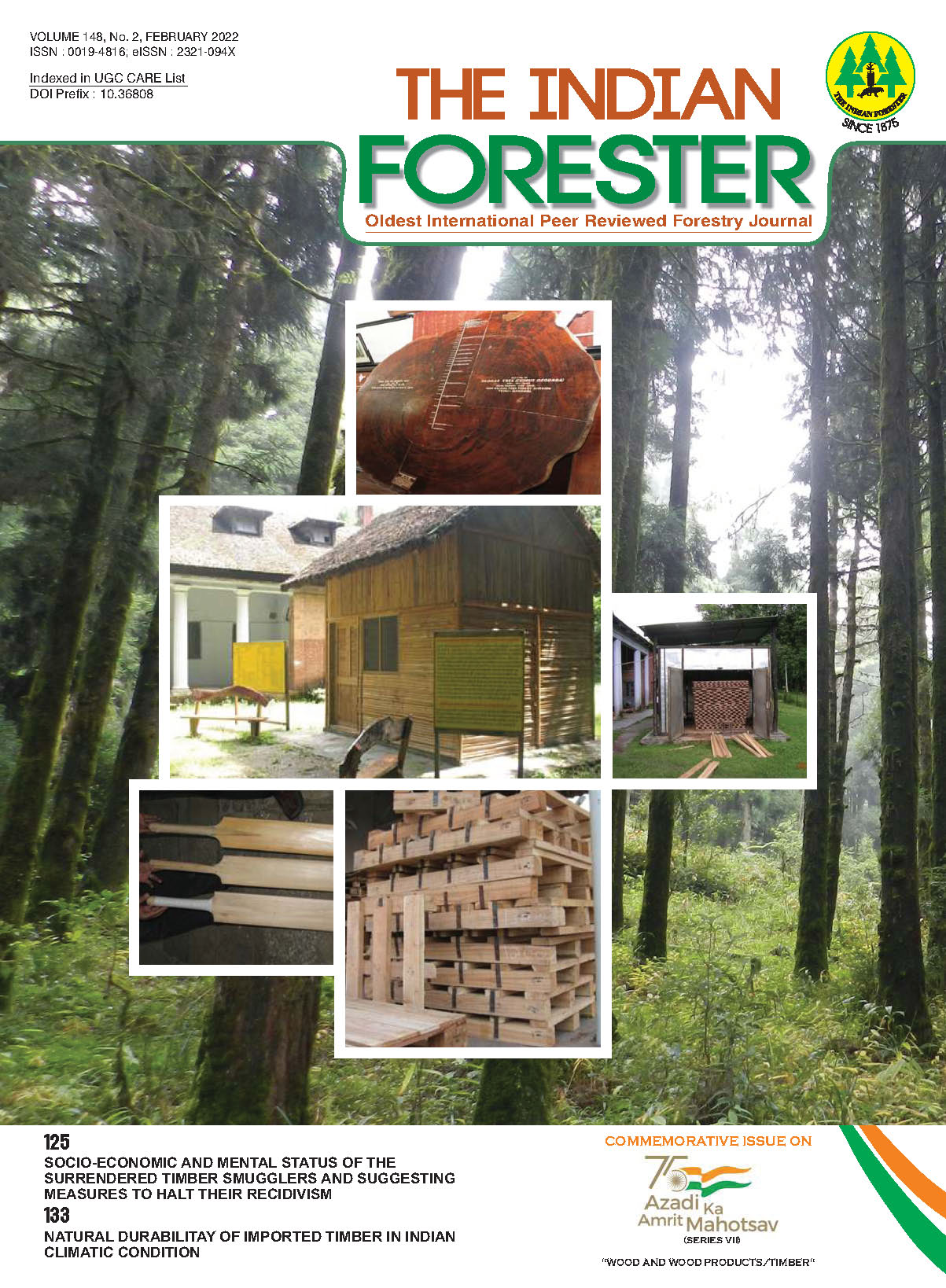Quantification and Consumption Pattern of Fuel Wood in Mornaula Reserve Forest in Kumaun, Indian Himalaya: Implication for Sustainability and Conservation
DOI:
https://doi.org/10.36808/if/2022/v148i2/155546Keywords:
Quantification, Consumption Pattern, Fuel Wood, Mornaula Reserve Forest, Indian Himalaya.Abstract
Present study provides information on biomass utilization, fuel wood species diversity, their regeneration status, and impact of fuel wood harvesting in Mornaula Reserve Forest (MRF) in Kumaun, India. A total of 34 plant species (32 trees and 2 shrubs) were collected by the inhabitants for fuel, belonging to 22 families, dominated by Rosaceae (04 species) followed by Pinaceae and Lauraceae (02 each). Distribution of plant species ranges from1500-2200 in a wide range of habitats, forests being the most preferred one. High preference and Resource Use Index of Quercus leucotrichophora, Quercus floribunda, and Rhododendron arboreum, Pinus roxburghii, Myrica esculenta, Symplocos chinensis, and Cedrus deodara as fuel indicated high pressure on these species. The continuous exploitation of these species from the MRF may lead to rapid deletion of their population. Therefore, adequate conservation measures have to be taken to maintain the current status of the habitats, species and communities for the effective management of the MRF. Awareness among the villagers needs to be created for the resource utilization techniques, so that sustainable utilization of the species could be done by the villagers. Further, the degraded forests may be re-established through plantations of the seedlings of the preferred fuel wood species with the participation of local inhabitants.References
Bansal M., Saini R.P. and Khatod D. K. (2013). Development of cooking sector in rural areas of India; A review, Renewable and Sustainable Energy Reviews, 17: 44-53.
Bhat B.P., Rathore S.S., Lemtur M. and Sarkar B. Fuelwood energy pattern and biomass resources in Eastern Himalaya. (2016). Renewable Energy, 94: 410-417.
FAO. (2016). Global Forest Resources Assessment 2015: How have the world's forests changed? Rome, Italy.
Gupta R.K. (1968). Flora Nainitalensis: A Handbook of the flowering plants of Nainital. Navayug Traders, New Delhi.
IEA. (2010). Energy poverty: How to make modern energy access universal? International Energy Agency, World Energy Outlook, Pari. www.iea.org (assessed on 27th Oct 2018).
IEA. (2017). Energy Access Outlook 2017 from Poverty to Prosperity. www.iea.org (assessed on 27th Oct 2018).
Jain R.K. and Singh B. (1999). Fuelwood characteristics of selected indigenous tree species from central India. BioresourceTechnology, 68(3): 305-308.
Kataki R. and Konwer D. (2001). Fuelwood characteristics of some indigenous woody species of north-east India. Biomass and Energy, 20(1): 17-23.
Maikhuri R.K. (1991). Fuelwood consumption pattern of different tribal communities living in Arunachal Pradesh in North-East India. Bioresource Technology, 35(3): 291-296.
Mathur, K.K. and Prasad J. (1976). Working plan for the west Almora Forest Division, Kumaun Circle, Uttar Pradesh (197677 to 1986-87), Nainital.
Misra R. (1968). Ecological Work Book. Oxford & IBH Publishing Company, Calcutta.
Naithani B.D. (1984 & 1985). Flora of Chamoli, Vol I - II. Botanical Survey of India, Howrah, New Delhi.
Negi V.S., Joshi B.C., Pathak R., Rawal R.S. and Chandrasekar K. (2018). Assessment of fuel wood diversity and consumption patterns in cold desert part of Indian Himalaya: implication for conservation and quality of life, Journal of Cleaner Production. 10.1016/j.jclepro.2018.05.237.
Osmaston A.E. (1927). A Forest Flora for Kumaun. International Book Distributors, Dehra Dun (Reprinted 1978).
Pangtey Y.P.S. and Samant S.S. (1988). Observations on the threatened, rare and endangered flowering plants and ferns in the flora of Kumaun Himalaya, Advances in Forestry Research in India, 3: 65-74.
Purohit A.N. and Nautiyal A.R. (2012). Fuelwood value index of Indian mountain tree species. International Tree Crops Journal, 177-182.
Purohit K. and Samant S.S. (1995). Fodder Trees and Shrubs of Central Himalaya. Gyanodaya Prakashan, Nainital.
Samant S.S. (1987). Flora of Central and South Eastern Parts of Pithoragarh District.Vol. I & II, Ph. D. Thesis, Kumaun University, Nainital.
Samant S.S., Dhar U. and Rawal R.S. (2000). Assessment of fuel resource diversity and utilization patterns in Askot Wildlife Sanctuary in Kumaun Himalaya, India for conservation and management, Environmental Conservation, 27(1): 5-13.
Samant S.S., Joshi H.C., Arya S.C. and Pant S. (2002). Studies on the structure, composition and changes of the vegetation in Nanda Devi Biosphere Reserve of West Himalaya. Final Technical Report submitted to Ministry of Environment and Forests, New Delhi.
Samant S.S., Joshi H.C., Pant S. and Arya S.C. (2001). Diversity, nativity and endemism of vascular plants of Valley of Flowers National Park. Himalayan Biosphere Reserves, 3 (1&2): 1-17.
Shanavas A. and Kumar B.M. (2003). Fuelwood characteristics of tree species in home gardens in Kerala, India. Agroforestry Systems, 58: 11-24.
Singh G. and Rawat G.S. (2012). Depletion of Oak (Quercus spp.) forests in the Western Himalaya: Grazing, Fuelwood and fodder collection. In: Global Perspectives on Sustainable Forest management, (Eds. Akais, O.C). Intech Open Publications, pp. 29-42.
Downloads
Downloads
Published
How to Cite
Issue
Section
License
Unless otherwise stated, copyright or similar rights in all materials presented on the site, including graphical images, are owned by Indian Forester.





